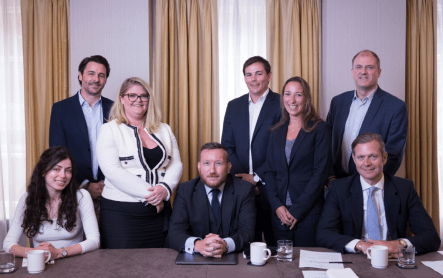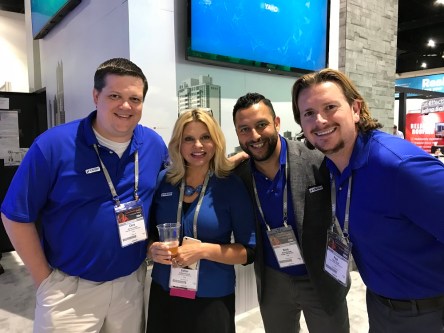A recent report presented by Better Buildings®, an initiative of the U.S. Department of Energy, and Global Real Estate Sustainability Benchmark (GRESB), an association dedicated to assessing and improving the sustainability performance of real estate assets, offered insight into the impact of sustainability certifications on commercial properties’ business performance in Los Angeles. David Hodgins, executive director of Los Angeles Better Buildings Challenge, presented findings showing that Class B buildings in Los Angeles with ENERGY STAR scores of 75+ achieved significantly higher occupancy rates and rent per square foot than non-certified Class A buildings there. Better Buildings’ findings were based on data from 263 ENERGY STAR-certified buildings and 526 LEED Certified buildings that illustrated the impact of ENERGY STAR benchmarking and certification on building occupancy and rental income. Co-presenter Dan Winters, head of Americas at GRESB, indicated the numbers are similar in other cities where studies have been done. Among the other Los Angeles findings: The average occupancy for ENERY STAR-certified buildings is 90%, vs the 84% current overall occupancy rate, which generates substantial gross annual rent increases The gross current asking rent per square foot (PSF) for ENERGY STAR buildings is $2.15, vs the current asking rent of $2 which also generates substantial gross annual rent improvements Los Angeles is benchmarking its most energy-intensive facilities and has pledged to reduce the energy intensity for 30 million square feet of city-owned and private buildings by 20% by 2020. More than 25 owners of large commercial buildings joined the challenge and report their results annually to help others save money and energy. The Los Angeles Existing Buildings Energy and Water Efficiency ordinance (EBEWE) has made energy efficiency a high priority in the city. This focus is paying off in multiple ways. The city ranked No. 1...
No Smoking Units
See How NALS Did It
Transitioning one property to a nonsmoking policy can be a challenge. But 49 properties? That’s no small feat. NALS Apartment Homes recently undertook this task, using the communication tools in RentCafe to help smooth the process. Keep reading to learn more about NALS’ decision to roll out a nonsmoking policy, the three-phase approached it used and the effect the shift has had on marketing, leasing and retention. Why Transition to a Nonsmoking Portfolio NALS began exploring options to reduce and/or eliminate smoking across its portfolio in 2015. After polling residents and staff, researching local laws and engaging with local chapters of the American Lung Association, it was determined that most properties would adopt a nonsmoking policy. According to the NALS 2017 Annual Report, “While the negative health effects of smoking influenced our decision, we were also motivated to mitigate the increased costs of cleaning a smoking apartment, the increased risk of fire caused by smokers and the disturbance that smoking causes to nonsmoking resident and employees.” Policy Change in Three Parts NALS approached the transition to nonsmoking gradually, to allow time for clear communication and minimize the impact on residents. “RentCafe was a huge help in making our nonsmoking policy a success,” shared Kayla Campbell, marketing leader at NALS. “We used RENTCafé to send out the initial surveys, and then to streamline what was communicated about the policy in our marketing, online applications and email correspondence. We also used the calendar and announcement functions in the resident portals to ensure the transition date was top-of-mind.” Phase 1 (2015): Surveys NALS sent out surveys to gauge interest at the properties, determine primary resident questions/concerns to address and to see which specific buildings were already effectively nonsmoking. Phase 2 (2016): Notice of Intentions A notice of...
Parks and Rec Month
5 ways to Celebrate
July is national Parks and Recreation Month. Rather than simply celebrating the beauty of green spaces—which in itself is worthwhile—the National Recreation and Park Association challenges you “to explore the ‘undiscovered’ roles of local parks and recreation, like science, technology, engineering and math (STEM) programming; senior programs; innovative health and wellness opportunities; community celebrations; outdoor education; flood mitigation; maintenance; and more.” How parks play a role in such a diverse range of topics may not be immediately evident. We’ve put together a cheat sheet of five ways to enjoy parks from a new perspective. STEM With its broad base, the connections between STEM and parks offer endless opportunities. Adult groups may consider volunteering with your local parks. Volunteers can learn about trail construction and maintenance, sustaining wildlife, building footbridges, and tracking park activity cycles. Kids may start by identifying the state bird, state flower, and other wildlife and foliage. Have them observe the habitat in which it grows and how its presence affects other living things. (For example, fireflies enjoy living near ponds where they can readily feast on smaller insects. They are prey for birds that also live near the pond.) Of course, all work and no play makes for a dull day at the park! Be sure to work in playtime among your exploration of STEM. Senior Programs Seniors feel a stronger sense of inclusion in their community when they have exposure to green spaces. This can include walks, yoga or Tai Chi, volunteering in park events, and outdoor meditation sessions. While interacting with nature is ideal, it isn’t mandatory for seniors to receive health benefits. Studies show that simply sitting in nature or viewing it can improve a persons’ mental health and sense of well being. Wellness Opportunities Many parks host...
Making Paper Vanish
With Yardi PAYscan
Accounts payable and accounts receivable are traditional hotbeds of activity for property managers, especially for large organizations with many properties and units under management. Boyd Management Inc. (BMI), has streamlined AR and AP by replacing thousands of paper invoices and check payments each month with electronic files that can be processed by staff with the convenience and efficiency of mobile devices. BMI began as a property developer and construction company in the late 1970s. The company built its first property in South Carolina financed under the United States Department of Agriculture’s Rural Development (RD) program. BMI still operates that property today, 40 years later. “We developed a lot of properties in the 1970’s, 80’s and 90’s. As tax incentive housing programs reformed during that period, we got a lot of calls from other RD property owners to buy them out. We grew significantly and are now the largest owners of USDA-financed properties in the country,” says Babbie Jaco, vice president and partner at BMI. Today, BMI oversees more than 350 residential properties in North Carolina, South Carolina, Georgia, Florida and Alabama. The regional portfolio adds to the challenge of a centralized accounting team that serves multiple properties, many in rural areas. Subsidies under management include everything from USDA and HUD 50059 to Low Income Housing Tax Credits. Through its affiliate, WWJ, LLC, BMI has also rehabilitated large portfolios of properties with creative financing and partnerships. “In 2008, we teamed up with Greystone Affordable Initiatives, CAHCEC, multiple state Housing Finance Agencies and other groups. Collectively, we developed our trademark housing preservation program, and the results have been phenomenal,” says Jaco. Through tax-exempt bonds and various affordable housing financing tools, the cooperative has preserved and renovated more than 6,000 units, with more than $170 million in...
Sales Tax Online
Supreme Court Ruling
It’s no secret that internet shopping has given brick and mortar stores a run for their money. Convenience and limited taxes has worked in favor of virtual retailers for years. A new internet tax law, however, tosses the ball back into the court of in-state stores. Sales Tax Law Revised The U.S. Supreme Court has ruled that states can now require sales tax on out-of-state purchases made online. The decision passed with a 5-to-4 vote, with those in favor on both sides of the aisle. Liberal Justices Anthony Kennedy and Ruth Bader Ginsburg were joined by conservative Justices Clarence Thomas, Samuel Alito, and Neil Gorsuch. The ruling removes protections from out-of-state vendors who could operate without charging sales tax, provided that they had no brick-and-mortar presence in-state. The old laws—created before the internet was even a dream–gave online retailers a competitive advantage. They could offer the same products at lower prices than in-state stores. Now, it will be up to the states whether or not they want internet retailers to charge sales tax on items sold within their borders. Some online retailers were already charging sales taxes. Others, such as Amazon, created a system of taxation that included sales tax on direct sales but excludes sales tax on indirect sales. It is uncertain how the ruling will impact such systems. Within the new law lies a few surprises. Small businesses will not be required to collect sales taxes if they generate less than $100,000 in sales and have fewer than 200 transactions in the state per year. This allows small enterprises, such as those you might find on Etsy, to build a following before the sales tax requirement hits. The law will also make available free sales tax collection software to help businesses adjust...
Build to Rent
Yardi UK Think Tank
Just a few years ago build-to-rent (BTR) was a rarely used phrase in the UK. Now it is one of the hottest real estate sectors around. A think tank of leading experts convened by Yardi and Property Week discuss the extent to which BTR has matured, the challenges it still faces and where the sector will go from here. The Think Tank Panelists: Andrew Cook – investment manager, M&G Real Estate (AC) Lora Salomidou – product owner, The Collective (LS) Rebecca Taylor – investment director, Long Harbour (RT) Katherine Rose – director of data & advisory services, Prsim (KR) John Dunkerley – chief executive and co-founder, Apache Capital (JD) Russell Markou – head of PRS operations,Tipi (RM) James Pargeter – projects director, Greystar Europe (JP) Chair: David Parsley – contributing editor, Property Week (DP) DP: How far along is BTR to becoming a mature market and is it now considered an institutional-grade investment? JD: There’s a big difference in people’s perception of where they think it is and where it actually is. There are 110,000 BTR units under construction or in planning. I don’t think we’re really scratching the surface yet. I don’t think it’s as advanced as people think it is. LS: The Collective has come from a slightly different angle to BTR and is focusing more on the consumer. The main reason we have got to where we are with BTR is because there has been a fundamental change in the expectations of consumers. The investors’ point of view is slightly different, but if we compare the return on investment from BTR to build-to-sell it is very different, because investors don’t have to manage the property – companies like us do it. JP: It’s certainly not yet mature in terms of finished...
Electronic Payments
5 Reasons You Need Them Now
It’s 2020 and there are still plenty of multifamily properties that are missing out on the benefits of electronic payments. If you’re still not sure if electronic payment processing is worth it, below are five great reasons to make the switch. Show prospects that you are not a dinosaur. Today’s renters expect electronic payments. A study by the NMHC/Kingsley reports that 92 percent of respondents consider online rent payment an important resident portal feature. If you’re operating under an outdated paper system, you’re making your neighboring competitors more appealing. Vendors will dig your modern ways, too. Vendors want to know that they will receive prompt payments for their services. Electronic payments eliminate the “check is in the mail” delay which can improve your relationship and promote faster service in the future. Make it easier for residents to give you their money. Electronic payments offer convenience, versatility and instant confirmation. That’s why 78% of renters prefer to pay electronically! You can also eliminate lost check disputes. All electronic payment transaction can be easily tracked. Automatic record keeping benefits you and your residents. Receive more payments on time. When residents can pay by ACH, debit or credit card, text, and WIPS they are more likely to pay on time. (Who wants to pay late fees?) Yardi client Roscoe Properties’ Mariana Estrada, Vice President, Operations explains, “We collected 95 percent of payments due — on time and electronically — thanks to Yardi Payment Processing. In the first week of the month we collected $9 million across our portfolio. That’s money in the bank without staff intervention.” Make bookkeeping easier. Automated payments save time and improve accuracy. Each transaction is organized and automatically entered into Yardi Voyager. There are no bank runs or batches to mail to corporate....
Social Senior Smarts
5 Health Benefits of Socializing
Social programming has long been a component of many senior living establishments. The quality and quantity of activities, however, vary greatly and may be affecting your residents’ health. The social programming at your site can contribute to the wellbeing and satisfaction of your residents, providing you with a competitive upper hand. Socialization Boosts Wellness Psychology Today reports on the health benefits of socializing. A few of the benefits include: Mental Fortitude: Interacting with other living beings has proven to improve memory and cognitive skills while fending off the onset and development of dementia. Mental Wellness: Face-to-face interaction minimizes the risk of depression, improves mood, and contributes to an overall sense of wellbeing. Longevity: Isolation can shorten our lifespans. Staying social helps to extend our lifeline regardless of our physical health history. Immunity: Socializing with others can strengthen seniors’ immune system. There is a complex relationship between our immune system and the regions of our brain that influence social interaction. Fitness: For seniors, interacting with others often includes getting out and doing things that they may not do alone. Social activities encourage seniors to stay physically active. Just How Long Ought We Socialize? How much socializing ought we pursue each day? Researchers suggest that we should aim for about six hours of interaction daily. This time can be spent with people, animals, or any combination of the two. That recommendation may not work for everyone, particularly for seniors who have gone for many years limited interactions. Easing into an a socially active schedule little by little may be a more appropriate approach. Ideas for More Social Seniors Below are a few ideas for the community as well as individuals that can help seniors reach the recommended six hours of social activity. Community Classes: While arts...
Smog Strategy
China Builds Towers
The issue of air pollution in China has been worsening in recent years, with the country forced to issue a red alert warning in January 2017 regarding toxic smog. A wide array of illnesses has been associated with air pollution, including dementia, Alzheimer’s and death. Studies reveal that by 2050, around 6.6 million people will die each year due to this problem. Thus, the development of air purifying technologies has become a critical need. The country has taken various measures to address the problem—only last year, China shut down 40 percent of its factories that failed to meet emissions standards, and announced the intention to ban non-electric cars. A year prior, in October 2016, Dutch artist Daan Roosegaarde installed a 23-foot (seven meters) high tower in a creative park in Beijing that took in polluted air and released it without the dust particles. The installation produces about 282.5 cubic feet (eight cubic meters) per second and was entirely powered by electricity generated by coal-power plants in China. Still, the amount of power needed to run was very little. This particular project inspired the Chinese officials to look further into the tower solution. A year after Roosegaarde’s tower worked its magic in Beijing, a larger one was erected in the Shaanxi province in central China. South China Morning Post reports that the tower is 328 feet (100 meters) tall, and reports show it has a positive impact on the air quality in surrounding areas. However, researchers at the Institute of Earth Environment at the Chinese continue testing the tower’s efficacy—it appears that the tower improved air quality over an area of 3.9 square miles (10 square kilometers) in the nearby city of Xi’an, and produced 353 million cubic feet (10 million cubic meters) of clean...
Hurricane Readiness
Senior Living Resources
Hurricane season is here! Even if you have a previously existing plan, it’s worth updating it with new resources for staff and residents. Check out these suggestions for thorough hurricane preparedness for senior living communities. Post evacuation plans in large print Ensure that building evacuation plans are clearly posted, in large print and with large graphics, on each floor of each building. It may also be helpful to email residents and their loved ones a copy of the city evacuation routes. Though they may not read it immediately, they will have it as a references when the time approaches. Prepare the property Make sure that gutters and downspouts are cleared for the best water management possible. Trim back trees and shrubs, particularly branches that are already weak or worrisome, to minimize property damage and projectiles. If residents are not required to completely vacate the property, ensure that there is an adequate store of plywood, nails, and other materials that can help maintenance fortify windows leading to units and public spaces. Honor staff efforts Create a way to honor staff that excel during times of crisis. Let them know that their efforts are appreciated by residents and leadership within the company. The Argentum Hero Award, for example, was given to Lisa Thomas for her work during Hurricane Harvey. Thomas is a life enrichment coordinator at Sabine Place, an Enlivant community in Orange, Texas. When the storm forced an evacuation of her community and several relocations as a result, Thomas made the most of the situation and left a lasting legacy at many of Enlivant’s sister communities during temporary stays. Residents: Create personal support networks The American Red Cross recommends that seniors create a personal support network. This network consists of multiple people who will check...
Easier Leasing
Affordable housing applications
Pinnacle Property Management Services (Pinnacle) manages a vast portfolio of residential, commercial and mixed use properties. Many of these are affordable housing units, developed under the Low Income Housing Tax Credit program. The many types of residential properties under management, including senior, student, affordable, luxury, market rate, etc., can present a challenge for leasing agents who must be well-versed in each vertical of the rental property industry. Affordable housing can be particularly challenging given the complexity of requirements necessary to comply with program requirements. Of course, the most basic of those requirements is that residents must qualify based on criteria such as income and assets. Documenting resident eligibility is the most important piece of a successful affordable housing program. Moving from paper-based applicant and resident files to electronic records is one of the ways the affordable housing industry is evolving to work more efficiently. Pinnacle is part of that evolution as it implements RENTCafé Affordable Housing. With RENTCafé Affordable Housing, Pinnacle saves time for leasing agents and ensures compliance with Low Income Housing Tax Credit program requirements. Those benefits result directly from changing to online housing applications and certification processes. “RentCafe Affordable Housing is such an amazing system when it’s used properly. If you haven’t used it, you’ll be surprised at how much time you can save and efficiency you can gain with it,” says Nick Strzelec. One of the biggest challenges of reviewing affordable housing applications is missing information. Using traditional paper forms, applicants can skip over questions they don’t have immediate answers to and forget to go back and fill in the missing data. Reviewers are stuck with an incomplete application and must reach out to the applicant to correct the omission. RENTCafé eliminates incomplete applications, which saves time for Pinnacle staff. “RENTCafé...
Energy Engagement
AT NAA Apartmentalize
A recent National Apartment Association study about apartment residents’ familiarity with and attitudes toward energy efficiency was the focus of an energy management panel at the recent Apartmentalize Powered by NAA conference in San Diego. The “Get Residents and Keep Them with Energy Efficiency Engagement” panel featured Martin Levkus, regional director for the Yardi Smart Energy Suite; Lexie Goldberg, senior associate for sustainability at Greystar; and Mary Nitschke, director of ancillary services for Prometheus Real Estate Group. Jenifer Paneral, senior vice president of operations at DayRise Residential LLC, served as the moderator. Last fall, NAA commissioned the Shelton Group to conduct a survey of 1,000 renters to understand the role of energy efficiency in choosing and staying in an apartment. The results were shared in Units magazine in June 2018 and presented to session attendees at Apartmentalize. The study revealed that property managers and owners can maximize resident engagement with energy efficiency. The study also found that mentioning energy efficiency at the first touchpoint is an opportunity to “get residents.” Twenty-five percent of residents participating in the survey said that knowing an apartment’s energy efficiency impacts their rental decision. According to Levkus, property managers can promote sustainability by making it convenient—and the key to convenience is technology. “Providing a portal that allows residents to easily view their consumption and pay their bills online empowers them to make changes that save money and make the property more sustainable,” he said. “Renters also like smart devices such as thermostats that increase their comfort but also reduce consumption and save money. The thermostats power down heaters and air conditioners when the unit is unoccupied.” Goldberg spoke of the importance of making energy and sustainability prominent on a property website. She described a Greystar community’s home page that...
Realcomm Recap
Huebsch, Teel talk trends
Yardi’s Rob Teel, senior vice president of global solutions, and Todd Huebsch, vice president of commercial sales, discussed key trends in the commercial real estate industry in interviews at the recent Realcomm and IBCon conferences. Excerpts follow. Q: What are some key shifts that you’re seeing in commercial property management? Huebsch: From an enterprise platform standpoint, software products historically have been developed for people in back office operations such as accounting and property management. Now we see the emphasis rapidly changing to the front office—people in the field who are managing leases, construction projects and facilities. Enabling that move is a series of mobile apps and role-based tools that simplify tasks and help front office people do their jobs faster, easier and more efficiently while seamlessly connecting to the back office. These new capabilities speak to reducing risk and increasing asset value Q: What is Yardi’s primary focus area at present? Teel: There are three. One is Yardi Elevate, which, in contrast to the traditional chief financial officer focus of property management software, is tailored to a chief operating officer whose direct reports might include the leaders of leasing, asset management, construction and facilities management. Another key focus is energy management, which addresses the needs of COOs and chief engineers who are looking to reduce consumption and expenditures and boost sustainability. Yardi has made five acquisitions in three years in this area and it’s one of our leading long-term strategic visions. And coworking has gone through a revolution in the last two years. Today about 1% of commercial offices in the U.S. are tagged as coworking space but we think it might go to 5-10% in the U.S. and globally within a few years. We made two acquisitions that brought us the Yardi KUBE...
RentCafe Reach
Now for Senior Living
We’re excited to announce that the advanced marketing services of RentCafe Reach are now available to our senior living clients. What is RENTCafé Reach? RENTCafé Reach is a set of advanced marketing services designed to help you attract more prospects to your communities. Our team of property marketing experts is available to help you with search engine optimization (SEO), pay-per-click advertising (PPC) and enhanced online listings. As a certified Google Partner, we’re ready to optimize your search and lead generation efforts. Because RentCafe Reach integrates with RentCafe and Yardi Voyager, you get accurate reporting and complete transparency into your data. SEO & PPC Services for the Real Estate Industry The RENTCafé Reach digital marketing team is comprised of Google certified experts in both Google AdWords for paid traffic and Google Analytics for organic traffic. This allows us to use Google as resource to answer questions and identify future opportunities. Our SEO services include: Optimized on-page content, page titles and meta descriptions Off-page optimization, including business citation and brand management Location data management through our partnership with Yext Regular website health audits and maintenance Monthly reporting, service calls and a dedicated account manager Comprehensive reporting to track results Our PPC services include: Strategic PPC advertising tailored to your goals Campaign management by Google AdWords Certified Specialists Ad targeting based on demographics, location, timing and mobility Ad extensions and landing pages to increase conversions Retargeting campaigns that follow engaged prospects We use white hat strategies, helping our clients improve website performance while actively protecting them against black hat techniques that get flagged by search engines. Stay Ahead of the Competition We understand how daunting it is to launch or manage a digital marketing program. And the challenges of working alone without experienced guidance. What is a...
Great Expectations
UK Retail Real Estate
LONDON – The evolution of the retail store in the face of growing online sales has been much written about, but shopping centres also can’t afford to be left behind in the age of ecommerce and changing technologies. This Retail Week report – produced in association with Yardi – explores how retailers view shopping centres and ways that centres can create an environment in which retail doors not only remain open, but thrive in a digital era. Based on interviews with 50 retail directors responsible for store portfolios – each representing a company with a turnover of between £50m and £10bn – the report finds strong similarities in what retailers want from shopping centres, and reflects changing shopper habits. Key themes are explored around how shopping centres can better support retailers, including expectations about infrastructure for technology and data, as well as how they can attract new entrants. The right mix between retail, leisure and dining is a fundamental attraction, while providing wi-fi is a prerequisite for retailers setting up shop in malls, which has both customer-facing and operational benefits. The future opportunities for shopping centres to enhance their performance, while diverse, are all underpinned by robust data. Decisions are increasingly data-led, and while current platforms – typically management software and spreadsheets – for data sharing have been well-received by retailers, there’s a strong feeling centre owners could provide more information. In particular, they want detail about footfall, dwell time and average spend, to better understand the local catchment and to adapt store space accordingly. Common themes for shopping centre investment over the next 12 months, according to our surveyed retailers, include keeping up with new technology, integrating ecommerce and opening new stores – all of which are elements that new entrants such as...
Smart Future
Multifamily AI Panel
What is artificial intelligence (AI)? According to Wikipedia, it is “The artificially created ability of a digital computer or computer-controlled robot to perform tasks commonly associated with intelligent beings.” While this definition of AI sounds like something from a sci-fi movie script, it actually describes technology currently poised to transform multifamily real estate management. Yardi’s Dharmendra Sawh, industry principal of Yardi Elevate, led a panel of experts at NAA Apartmentalize on June 14 in San Diego for “The Age of AI: Business Intelligence Today and Tomorrow.” Apartmentalize is NAA’s annual educational conference and is the premier resource for educating rental housing industry professionals. Along with Michael Barry, vice president of data analytics at Bozzuto Management Company, Tim Reardon, chief operating officer of Bridge Property Management and Dawn Wise, national financial analyst at Berkshire Communities, Sawh discussed best practices for business intelligence (BI) today and the looming impact of AI on multifamily business technologies. “BI tools deliver analytics to provide foresight, improve business decisions and increase your competitive edge. But soon, your software could be making those decisions for you. Tracking the right measures can help future-proof your analytics in anticipation of AI,” said Sawh. The presentation covered which performance measures are most important, how technology can track that data and how to analyze and act on that information to create a successful business strategy. The session wrapped with a preview of what’s coming for multifamily owners and managers with advancements in AI. Beyond BI The panel discussed predictive and prescriptive analytics for real estate management, and the role machines will play as interpreters of data. Machine learning is a component of AI that uses historical information and correlates multiple data points to make predictions about the future — and as a result, becomes more...
Get More Leads
Maximize Content Life
Many content creators are only getting one use out of blog posts. You are missing out on countless opportunities to get noticed by potential renters! Get more from your blog with repurposed content. What Is Repurposed Content? When you repurpose content, you’re finding different ways to tell the same story. Each new way that you tell your story may appeal to a different group of people. For example, when you create a blog post, you tell the story to readers. You can tell that same story to visual learners using video on YouTube or pictures on Instagram. By appealing to different types of learners (or different types of entertainment) you reach a greater audience. A broader audience increases your prospect pool and your potential for leads. Below are a few ways that you can repurpose your blog content to reach new groups of prospects. Master Infographics Infographics are a great way to combine facts from your blog text with visual media. Infographics can be consumed anytime, anywhere because they are not hampered by audio access, buffering speeds, and data availability. Many content creators love infographics because they don’t require photography, video, or illustration skills. Many programs allow you to drag-and-drop into templates to create fantastic infographics. Try making your own free infographics using Venngage or Picktochart. Curate an Instagram Slideshow For a short blog post, you may only have one image. You can use that image to create an Instagram post, including a teaser excerpt for your blog post. (Unless you’re paying Instagram for clickable links within captions, be sure to put the link for your blog post in your bio.) For multiple images on a blog post, create a slide show. Rather than several posts on the same topic, a slideshow allows you...
Fit4Life
Yardi Pune
Let’s face it: it’s hard to stay active in a corporate setting. Encouraging employees to live a healthy lifestyle while also expecting eight hours of productivity—often in front of a computer—can be a challenging directive. But what if an event was fun, healthful, and allowed employees to bond by overcoming adversity and encouraging one another? That event is the Fit4Life Corporate Challenge Program. Hosted by Tata Consultancy Services (TCS), Fit4Life is a 10k race that promotes physical fitness and unity amongst teams of at least four participants. Race participants are encouraged to train together, motivate each other, and reach new personal goals by race day. Yardi Pune represented well this year with 291 employees. There were 69 women in the group, a spectacular turnout. Rushabh Mutha, Associate Client Account Executive, CSD at Yardi was one of the proud participants. He recalls, “Race day was very pleasant. In the morning, the weather was a bit chilly. In spite of the cold, I was very excited. Everyone was so full of enthusiasm.” Mutha adds, “The arrangements made by TCS were very nice. There were large, festive markers for the start and finish line. There was also a place where you can take a picture that says, ‘I am a finisher.’ I felt very proud to participate.” Undoubtedly, Mutha’s favorite part of the event was finishing. “The most fun part was completing the race and holding the Yardi trophy!” he smiles. The event was particularly special for Mutha because it was not only his first race, but it is also his first year with the company. Fit4Life encouraged him to meet new coworkers and develop stronger relationships with familiar faces, all while getting fit. “As I just joined the company, it was fun meeting other Yardi employees,...
Pet-Friendly Work
Office Options for Furry Friends
Much ink has been spilled on the topic of Millennials and their influence on the modern workplace. This tech-savvy generation is willing to change tracks towards a more satisfying career path, and able to ride the rough waves of the gig economy. Millennials’ demand for a lively urban life is driving the revival of downtowns across the nation, and the development and expansion of a new office design plan: the coworking office. To go with this new office concept, employers are further trying to entice workers with a series of office perks that address the preferences and values of this generation. Office listings platform COMMERCIALCafé looked at one of the most recent additions to the growing range of work benefits―the option of bringing your pet to work―and compiled a list of the 50+ most pet-friendly coworking hubs in the U.S. Peruse the list below and read on for more details about the pros and cons of bringing pets to the office. The list is by no means comprehensive and remains open to suggestions. Among the venues that caught our attention is the whimsically named CO+HOOTS in Phoenix―recently acclaimed one of the most innovative coworking spaces in the U.S.―which invites visitors to meet the office dogs. Strongbox West in Atlanta―the city’s oldest coworking space―is not only a self-declared dog-friendly office, but a veritable ‘doggy daycare operation.’ The Box Jelly in Honolulu holds different events for owners and their pets, and they don’t shy away from welcoming unconventional companions. If you’re considering adopting a pet-friendly policy in your office, it’s good to weigh both pros and cons. There are several benefits of spending your workday with your beloved furry friend. For one, you can stop worrying about its safety and hurrying out the door as soon...
Risky Business
Are Your Properties Protected?
A recent Yardi Matrix research bulletin titled “Flood and Fire: The Multifamily Sector’s Response to Natural Disasters,” assesses the state of U.S. multifamily markets in areas hit hard by natural disasters in 2017 including hurricanes and wildfires. Hurricanes alone caused around $110 billion in total reported property damage. The bulletin also covers the impact of these events on the insurance market, and advises that property owners in the private insurance market should be ready for increasing rates and deductibles along with tightening policy terms and conditions. It’s Hurricane Season Again As cited in an April 2018 Multifamily Executive article, the U.S. was hit with 16 severe weather events in 2017. And now that this year’s hurricane season is underway, property owners and managers should ensure that their communities are as safe and sound as possible to prevent against future losses should a major storm hit. One key tip: install critical infrastructure above flood-prone areas. Recommended actions outlined in the article include relocating electrical panels, mechanical equipment, meters and shut-offs to higher ground. Sealing cracks in walls and foundations and installing sump pumps will go a long way to shoring up a property. Using materials that are designed to survive water exposure and resist mold for framing, wallboards, floorboards and ceilings is also a great plan. Mitigating Property Risk When it comes to safeguarding properties, being ready for extreme weather isn’t the only consideration for property owners. To protect against resident-caused damages, a required renters insurance program is a widely accepted industry best practice. For property owners without renters insurance at their communities, now is a great time to consider implementing a program to mitigate risk. A program that includes fast and easy signups for residents and automated compliance monitoring for property managers is ideal....




















